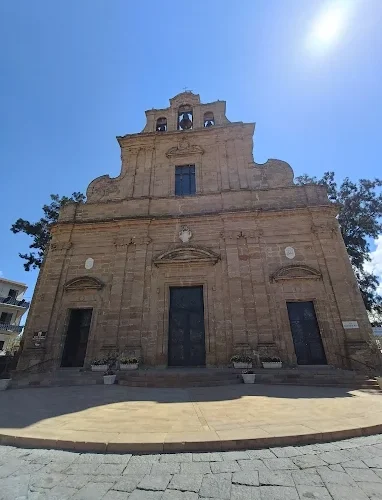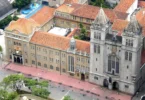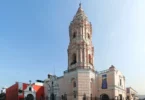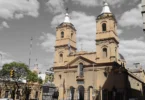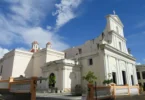Introduction
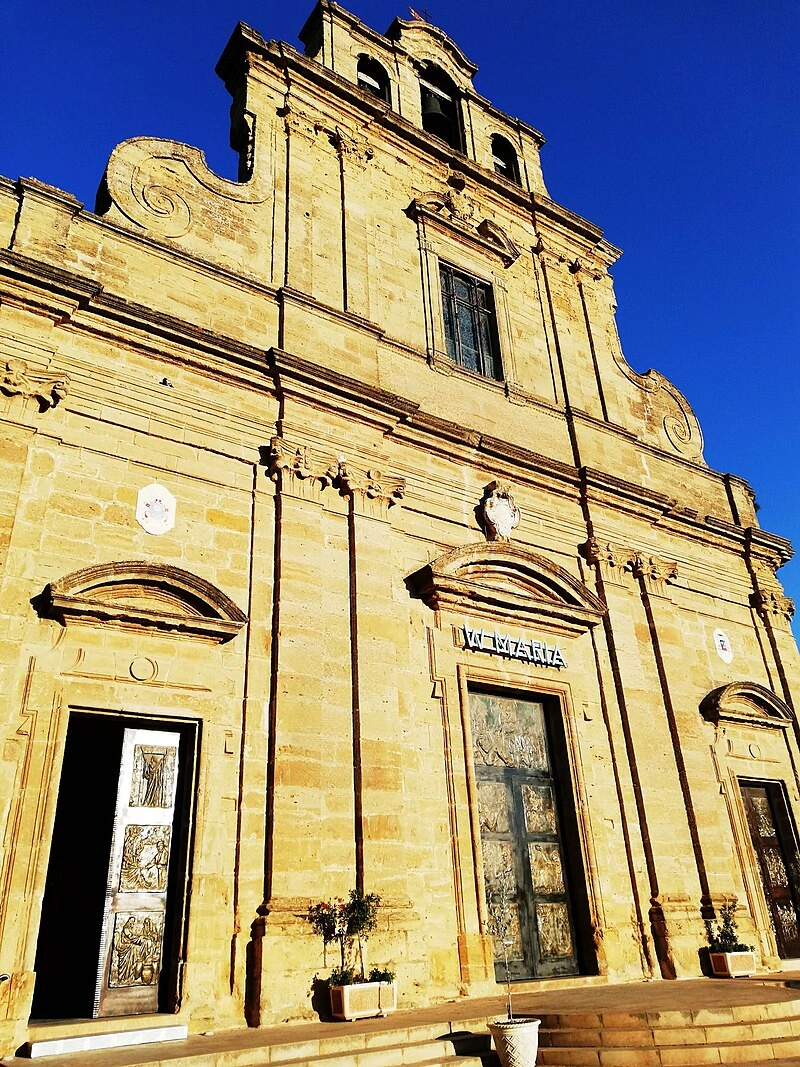
The Basilica – Sanctuary of Maria Santissima del Màzzaro, also known as Santa Maria Maggiore, is one of the most significant places of Catholic worship in the city of Mazzarino and holds an important position within the Diocese of Piazza Armerina. The sanctuary is dedicated to the Madonna delle Grazie, the patron saint of Mazzarino, who is venerated under the title of “Màzzaro.” It is a central religious and cultural landmark in the area, drawing both local worshippers and pilgrims from afar. Located in the historic center of Mazzarino, the basilica stands prominently at the northeastern end of Corso Vittorio Emanuele, one of the city’s main streets. It serves as a focal point of faith and devotion for the residents and visitors alike. The structure of the basilica is a distinguished example of late Baroque architecture, a style that became widespread in Sicily following the massive devastation caused by the earthquake of 1693. This earthquake affected much of the Diocese of Syracuse and the Val di Noto, including Mazzarino. The reconstruction efforts in the aftermath led to the flourishing of Baroque architectural styles across the region, which is evident in the design of the basilica.
The construction of the basilica began in 1739 and was designed by the Syracusan architect Carmelo Natale Bonajuto, affectionately known as “Santuccio.” The initiative for the creation of the church came from Capuchin friar Ludovico Napoli da Mazzarino, a servant of God the Father, who lived from June 27, 1708, to April 23, 1764. The friar played a crucial role in the establishment of the sanctuary. The financial backing for the church’s construction came primarily from donations by the local population of Mazzarino, in addition to proceeds from land rents owned by the church. A significant contribution was made by Don Ercole Michele Branciforte Gravina, the Prince of Butera and Count of Mazzarino. Furthermore, the facade of the church was financed by a generous donation from Luigi Sortino Orsini, a knight and Captain of the Grenadiers of Syracuse. Today, the Basilica of Maria Santissima del Màzzaro holds the esteemed title of a Minor Basilica and is officially recognized as a diocesan Marian sanctuary. It continues to serve as a key place of worship, reflection, and pilgrimage, preserving both its spiritual significance and historical legacy within the heart of Mazzarino.
Norman Era and the Discovery of the Icon (1125)
The history of the Basilica of Maria Santissima del Màzzaro dates back to 16 September 1125, marking a significant event in the religious and cultural history of the area. According to popular legend, it was on this date that a shepherd discovered a sacred image of the Madonna delle Grazie in an underground cave, which was later to become the site of the basilica. The shepherd, tending his flock, noticed that one of the pigs repeatedly moved toward a specific area of the forest. Investigating, the shepherd uncovered a hole in the ground leading to an underground space. Inside, he found a lit lamp illuminating a painting of the Madonna between the Sicilian saints Agatha and Lucia, along with a crucifix.
The discovery prompted great excitement among the local people. The shepherd, astonished by the find, ran to alert his master, and together with a large crowd of citizens and clergy, they retrieved the sacred image. The icon was soon venerated, and a special altar was erected in the Mother Church of Mazzarino, where it became a focal point of devotion for the community. The image was proclaimed “Patron and Protector” of Mazzarino, taking the title “Maria delle Grazie”, and later, Santa Maria del Mazzarino—a name which was eventually shortened to Maria del Màzzaro.
The Madonna delle Grazie was depicted in the painting seated between Saint Agatha (the virgin martyr of Catania) and Saint Lucia (the virgin martyr of Syracuse), emphasizing the sacred connection to the region’s martyrs.
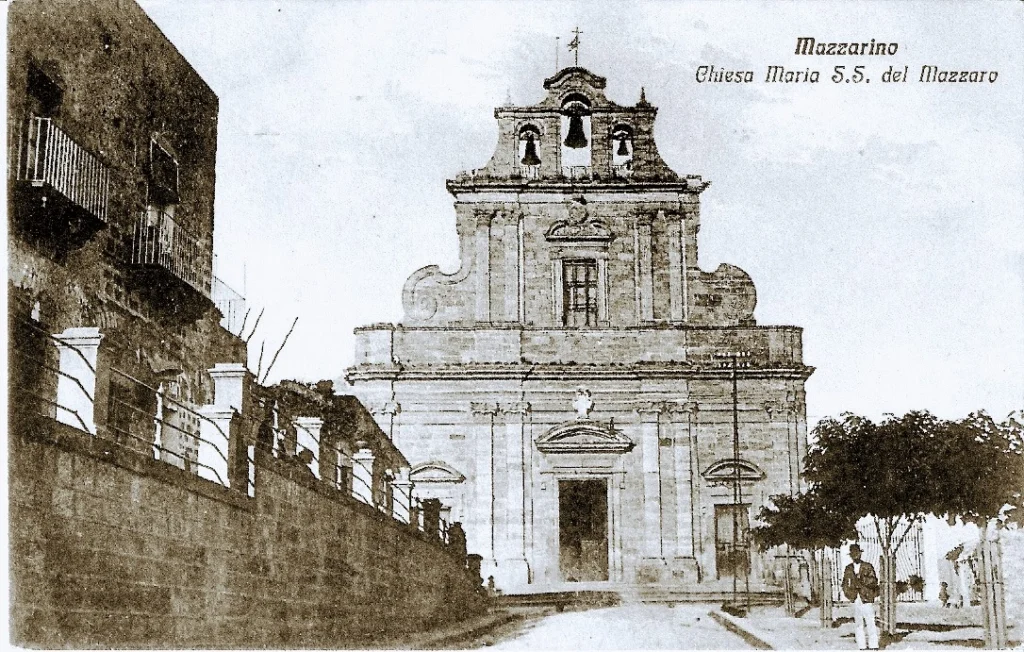
Early Church Construction (1125)
In 1125, on the exact site of the discovery, a small chapel was built by Marquis Enrico del Vasto, the lord of the cities of Mazzarino and Noto. The chapel was constructed to house the sacred icon and provide a place for the people to venerate the Madonna. This early church was dedicated to Our Lady of Màzzaro, in honor of the site of the miraculous discovery, and the image was placed in the church for public worship. Over time, the Madonna’s veneration spread, and she became known as the Patroness of Mazzarino.
Expansion and the Second Church (1154)
As the veneration of the Madonna grew, the need for a larger, more impressive church became evident. In 1154, Count Manfredi del Vasto, the son of Simone del Vasto, who had become the new lord of Mazzarino, decided to replace the original chapel with a larger, more elegant church. This new church was designed in a Greek-Norman style, with a single nave and a pointed arch entrance, characteristic of the period. The new church, constructed around the same site, was consecrated in April 1154 by Girolamo, the bishop of Otranto. This event took place during a time when the episcopal seat of Syracuse was vacant, and Mazzarino fell under the jurisdiction of the bishop of Otranto. Count Manfredi funded the construction of the church, including making significant donations for its upkeep, which helped to ensure the long-term preservation of the sacred site.
The second church, which stood for centuries, was a modest structure compared to the current basilica. It consisted of a single nave and faced south, with the entrance marked by a pointed arch typical of the Greek-Norman style. The church’s simple design and functional features were appropriate for the community’s needs at the time. Over the years, the church underwent repairs and renovations to maintain its structural integrity. A plaque placed at the entrance commemorates the significant contributions made by Count Manfredi and his wife Beatrice, who were instrumental in supporting the church’s construction and its eventual consecration.
Destruction and Rebuilding (1693 Earthquake)
The church, like many buildings in the region, suffered considerable damage during the devastating Val di Noto earthquake of 11 January 1693. The earthquake rendered the church unusable, and it remained in a state of disrepair for many years. During this time, the faithful continued to venerate the Madonna’s image, but the church itself could not accommodate the growing numbers of pilgrims who came to pay homage.
Restoration and Final Construction
In the late 17th century and early 18th century, restoration efforts began to rebuild the church. The church’s structure was completely overhauled, and it was eventually replaced by the current basilica, which was consecrated in April 1154. The basilica today is a symbol of faith and history for the community, preserving the story of the miraculous discovery of the Madonna delle Grazie and her significance to the people of Mazzarino. The Basilica of Maria Santissima del Màzzaro is now a minor basilica and remains a central place of worship, with its rich history and religious importance continuing to resonate with the people of Mazzarino and the many visitors who come to venerate the Madonna del Màzzaro.
Spanish Era: The Late Baroque Reconstruction After the 1693 Earthquake
On January 11, 1693, a powerful earthquake struck southeastern Sicily, causing widespread destruction and loss of life. Mazzarino, along with many other cities in the Val di Noto and the Diocese of Syracuse, was heavily impacted, with several of its oldest religious buildings suffering significant damage. Among these was the Church of Santa Maria del Mazzaro, a Norman structure, which was rendered unusable by the tremors. However, as the registers of the mother church suggest, there were no casualties among the citizens during the earthquake. The earthquake’s damage to the existing church of Madonna del Mazzaro prompted the decision to reconstruct a new building in the prevailing Baroque style. The reconstruction project was led by the Capuchin friar Father Ludovico Napoli, who worked alongside the episcopal curia of Syracuse, which was under the leadership of Bishop Matteo Trigona. The local population played a crucial role in funding the construction, contributing through donations, alms, and the labor of local craftsmen.
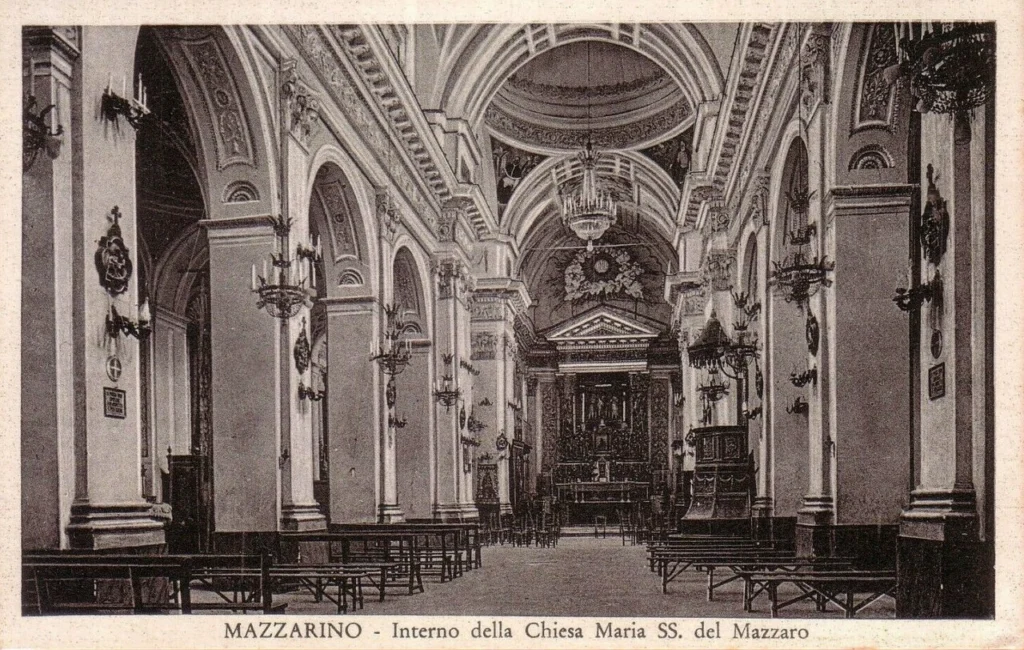
Bourbon Era: The Start of Reconstruction in 1739
In 1739, the renowned architect Natale Buonajuto from Syracuse was commissioned to design the new church, which would reflect the late Sicilian Baroque style. The construction process officially began in 1755, and the church was completed in 1782. The building’s costs were mainly covered by the local community, donations, and proceeds from the sale of honey produced by the church’s hives. These funds were raised in response to a devastating drought in 1736, which had caused hardship for the local population. The Prince of Butera and Count of Mazzarino, Ercole Michele Branciforte Gravina, made a substantial financial contribution, as did Father Ludovico Napoli, whose work and leadership were essential in the church’s restoration. While the church was already in use by 1762, the Caltagirone tile flooring was not laid until 1775. In 1774, the stucco artist Raimondo Stornelli was commissioned to create the decorative stucco elements above the chapel of the Blessed Sacrament and the sacristy.
Completion of the Facade and Decoration: The 19th Century
The church’s facade was completed in 1782, thanks to a donation from the knight Luigi Sortino Orsini, which allowed for the finishing touches to be added to the building’s exterior. After the construction was finished, the interior remained undecorated for over 50 years, although it was used for worship during this period. In 1847, the Palermitan artist Giuseppe Utveggio carried out the decorative stucco work, which featured floral motifs and festoons. The interior decoration was further enhanced by frescoes painted by Giuseppe Carta in 1855 and Pasquale Conti in 1864. Once the embellishments were completed, a solemn procession took place in 1855, during which the painting of the Virgin, which had been temporarily housed in the nearby Church of Sant’Antonio Abate, was relocated to the main altar of the basilica.
Post-Unification Era: The Madonna del Mazzaro's Statue and High Altar
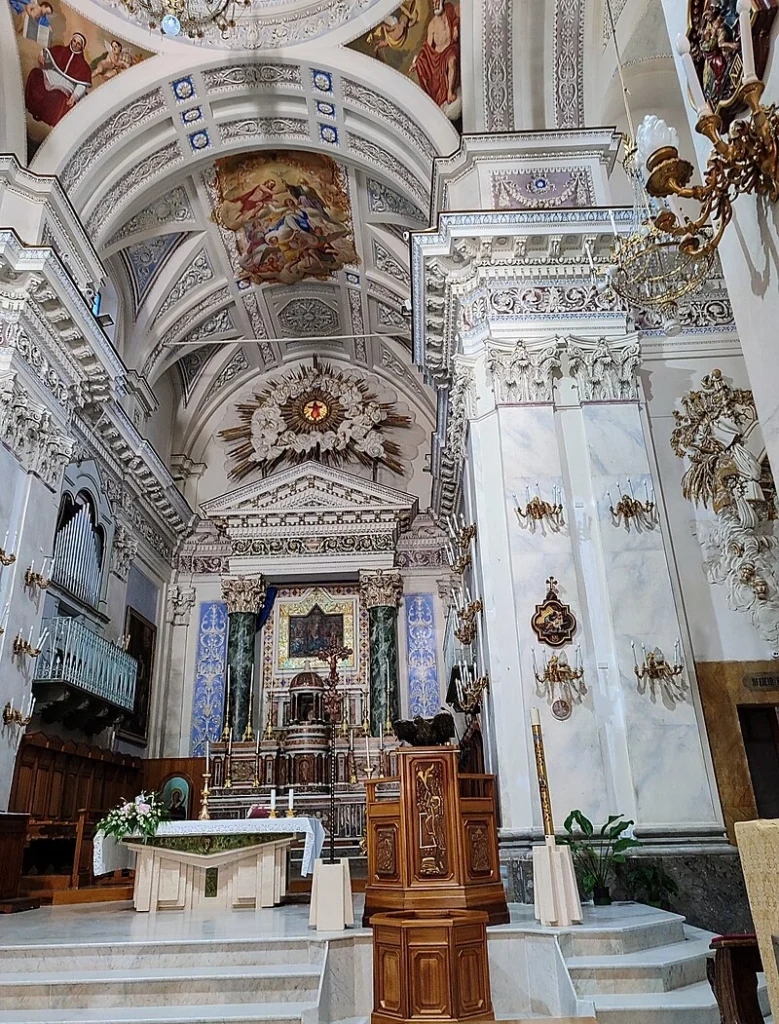
In 1874, a wooden statue of the Madonna del Mazzaro was commissioned from the Palermo sculptor Vincenzo Genovese. The statue was delivered in August 1875, and it was crowned by Monsignor Saverio Gerbino in a ceremony on September 13, 1876. The silver crowns of both the Madonna and the Child Jesus were consecrated during this event. A major construction project took place in 1881, when the old wooden altar was replaced by a new high altar made of polychrome marble. This new altar was created by the marble worker Antonino Piazza, based on a design by Giuseppe Giunta-Bartoli. The cost of the new altar amounted to five thousand lire, and a plaque behind the altar commemorates the construction, which was completed in 1881. In 1883, the basilica was solemnly consecrated by Bishop Saverio Gerbino, 729 years after the original consecration in 1154. The dedication ceremony also included a special blessing for the newly completed altar. A plaque at the entrance of the church commemorates this important event.
Modern and Contemporary Era
During the Jubilee Year of 1900, the bishop of Mazara del Vallo, Monsignor Gaetano Quattrocchi, who was originally from Mazzarino, crowned the painting of the Virgin in a special ceremony. In 1924, the bishop of Piazza Armerina, Monsignor Mario Sturzo, established the parish of Santa Maria Maggiore. Prior to this, the basilica had served as a suffragan church for the Mother Church of Santa Maria della Neve. Between 1973 and 1975, the church underwent modernization works, including the reconstruction of the churchyard and the organization of the rooms beneath the church. In 1978, the bishop of Piazza Armerina, Sebastiano Rosso, declared the basilica a diocesan Marian sanctuary. In the 1990s and early 2000s, significant consolidation and restoration works were carried out on the church’s foundations and naves, thanks to the efforts of the Superintendency for Cultural Heritage of the Sicilian Region. In 2006, Pope Benedict XVI elevated the basilica to the status of a minor basilica, linking it to the papal basilica of Santa Maria Maggiore in Rome.
The Deed of Donation by Count Manfredi del Vasto (1154)
The historian Pietro di Giorgio Ingala, in his 1889 work Research and Historical Considerations on the Ancient City of Mazzarino, reports the full text of the solemn donation made by Count Manfredi del Vasto in 1154. This donation, which took place during the consecration of the church by the Bishop of Otranto, Girolamo, is an important document in the history of the church and the region. The preamble of the donation references the Norman King William I and the royal genealogy. Manfredi del Vasto, the son of Count Simon, donated lands to the church of Santa Maria del Mazzaro in perpetuity, to ensure the salvation of the souls of King Roger, his wife Adelaide, and others, as well as to guarantee the church’s continued prosperity and influence. The document was signed by Bishop Girolamo of Otranto, confirming the validity of the donation. The act is an example of the deep religious and political ties between the Norman rulers, the church, and the local population of Mazzarino, as it provides both spiritual and material support to the church’s establishment and future.
The full Latin text of the donation reads as follows:
Full Latin Text of the Donation (1154)
(A translation of the original Latin text of the deed of donation follows, detailing the specifics of the lands donated, the guarantee of eternal ownership, and the various religious figures involved in the ceremony.) “In nomine Domini Nostri Jesu Christi Dei aeterni…[text continues with the formal donation details, the religious invocation, and the clauses about land and property management].”
Architecture of Basilica Sanctuary of the Most Holy Mary of Mazzaro, Mazzarino, Sicily, Italy
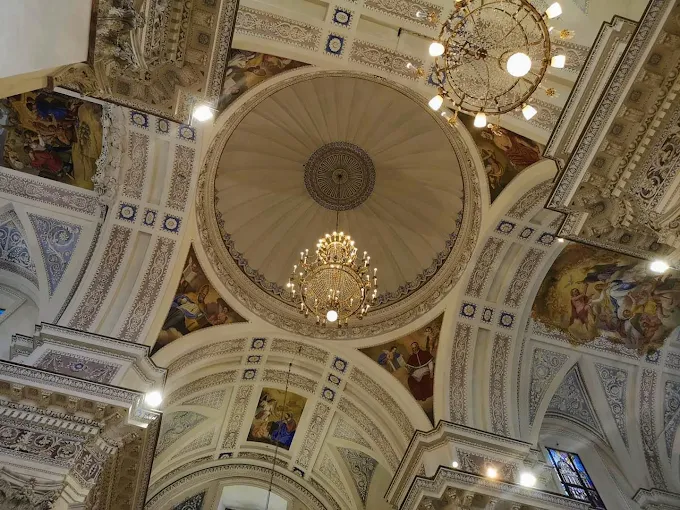
Architectural style: Baroque architecture
Exterior of the Basilica
The Basilica of Maria Santissima del Mazzaro follows a Latin cross plan, featuring an apse and presbytery that align with the central nave. It is designed with two lateral altars positioned in the transepts. The structure has a longitudinal layout, facing westward, and overlooks the semicircular churchyard made of local limestone, which connects to Piazza Regina del Mazzaro.
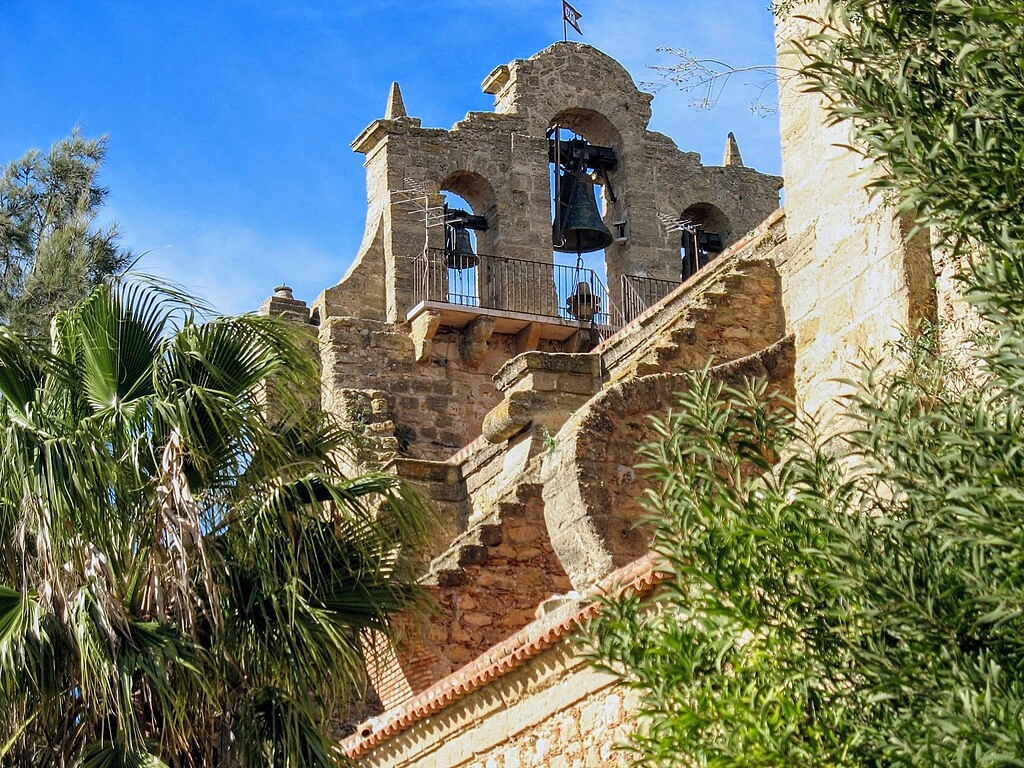
Facade
The basilica’s eighteenth-century façade, crafted from blocks of local sandstone, exemplifies the late Sicilian Baroque style, with a distinctive pyramidal structure commonly seen in Baroque church architecture in the Val di Noto region. The façade is divided into three levels, separated by projecting cornices and string courses adorned with intricate mouldings. Twin pilasters frame the central door, which is crowned with Corinthian capitals. The lower level features three entrances corresponding to the church’s three naves, interspersed with two pairs of pilasters. These doors are topped with semi-circular tympanums and depressed arches. Between 1980 and 2014, three bronze doors were installed, each bearing the handprints of the last three popes: St. John Paul II, Benedict XVI, and Pope Francis. Above, the second level showcases a large window that illuminates the central nave, topped with a broken tympanum and flanked by pilaster strips and volutes. The third level is dominated by a bell tower housing three bronze bells from the Gerbino foundry in Caltagirone, cast in the late 19th century.
Interior of the Basilica
The interior is divided into three naves by ten arches supported by square-section pillars—five in each of the lateral naves. These pillars are enhanced with stucco decorations, pilaster strips, and Corinthian capitals, and they support a cornice adorned with denticulated mouldings and floral motifs. This design was created by Palermo artist Giuseppe Utveggio in 1847.
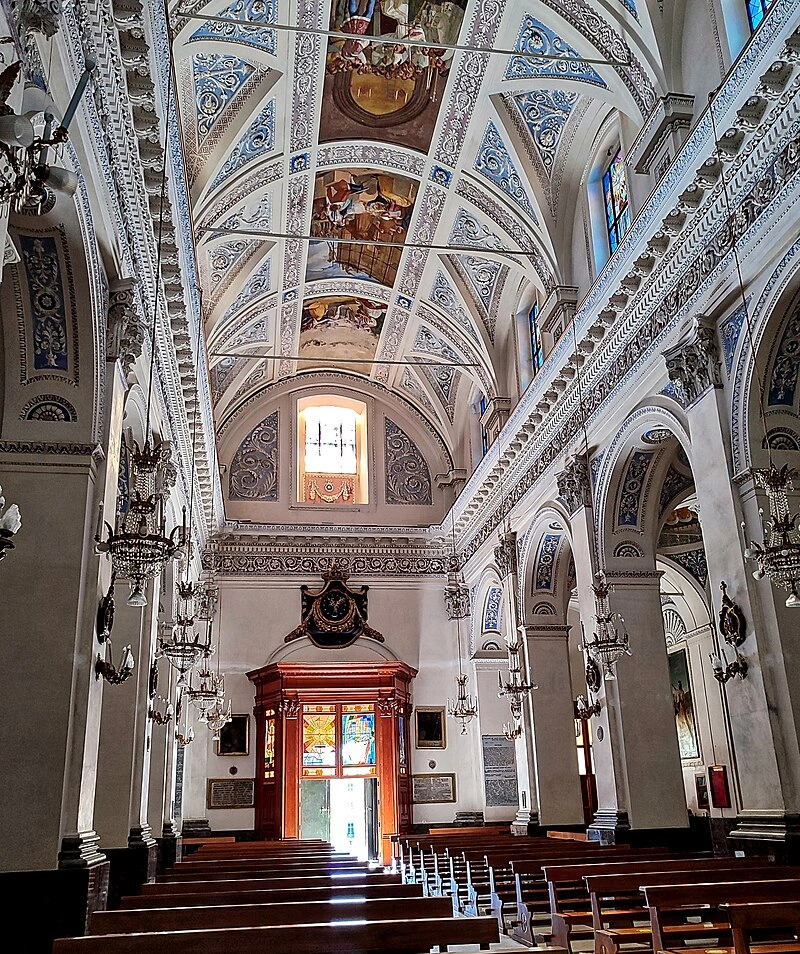
Central Nave
The central nave of the basilica is characterized by a striking lunette vault made of reeds, which is richly decorated with stucco elements featuring floral motifs and a range of chromatic contrasts. Within this decorative scheme, several panels painted by Giuseppe Carta illustrate significant historical moments in the church’s history. The panels capture the discovery of the icon of the Virgin of the “Mazzaro”, the first procession of the icon, the consecration of the church in 1154 by Bishop Girolamo and Marquis Enrico del Vasto, the construction of the new basilica in 1763, and the grand procession of 1855 marking the completion of the church’s decorative works. Additionally, the pendentives beneath the false dome feature painted depictions of four key Church Fathers: Saint Jerome, Saint Ambrose, Saint Augustine, and Saint Gregory the Great. These works, crafted by Palermo artist Pasquale Conti, also include notable representations of the Annunciation and the Visitation of the Virgin, further enhancing the rich iconographic narrative of the basilica.
Side Aisles
The side aisles of the basilica, which correspond to the spans of the central nave, are elegantly covered by false dome vaults set on square bases. These aisles house numerous altars, each displaying significant works of art from the 17th and 18th centuries, primarily from the Sicilian school of painting. These altars are dedicated to saints, the Virgin Mary, and various religious themes, contributing to the rich spiritual and artistic heritage of the basilica.
Right Aisle:
The right aisle of the basilica is home to several altars, each with its own unique significance and artistic merit. The first bay features an altar dedicated to the passing of Mary, with a striking canvas that poignantly captures this solemn moment. In the second bay, an altar displays a painting of “Glorious Saint Joseph,” created by Antonio Ballistreri, celebrating the saint’s role in the Holy Family. The third bay hosts an altar dedicated to Saint Ursula, adorned with a beautiful canvas by Bernardino Bongiovanni, a distinguished artist from Caltagirone. Moving to the fourth bay, an altar features a canvas of the Assumption of the Virgin, painted by Domenico Provenzani in 1872, depicting the Virgin Mary’s ascent into heaven. The fifth bay, located in the right transept, houses a revered statue of the Sacred Heart of Jesus, which serves as a powerful focal point for prayer and devotion.
Left Aisle:
The left aisle of the basilica features several altars, each highlighting significant religious figures and events. In the first bay, the baptismal font is enclosed by an iron gate, and a canvas depicting the Baptism of Jesus by Giuseppe Perno Moscato adds a spiritual touch. The second bay hosts an altar dedicated to Pope Saint Sylvester, with a painting that honors his legacy. The third bay displays an altar dedicated to Saint Mark the Evangelist, featuring a notable painting by Bernardino Bongiovanni, created in 1751. In the fourth bay, an altar showcases a canvas of the Virgin “Refuge of Sinners”, painted by an unknown artist, symbolizing Mary’s role as a protector. The fifth bay is home to an altar dedicated to Saint Biagio, with a painting by Bernardino Bongiovanni, also from 1751. Finally, the sixth bay in the left transept houses a remarkable wooden Crucifix from 1125, an important relic that connects the church’s history to its early centuries of worship.
In 1868, the central nave and transepts were illuminated by 15 crystal chandeliers, which were funded by the clergy, local butchers, and the community. Additionally, in the 1970s, the basilica underwent renovations, including the installation of a new Carrara marble floor to replace the previous one, which had become worn over time.
Organ
The pipe organ of the basilica, positioned in the choir area to the left of the apse (cornu evangelii), is a distinguished instrument built by the acclaimed Damiano Polizzi organ factory of Caltanissetta. Inaugurated on 31 May 1916, it features 19 registers and employs a mechanical transmission system with return. The organ includes two manuals of 58 keys each (C1–A5), a 17-note pedalboard (C1–E2), and a window-style console. Among its accessories is a tremolo, which enhances its expressive capability. This historic organ continues to serve as a vital element in the basilica’s musical and liturgical life.
Icon and Relics
The basilica’s most revered item is the Byzantine icon of the Blessed Virgin Mary of Mazzaro, discovered in 1125. The icon is a Greek-Byzantine style triptych painted on wooden boards, depicting the Virgin Mary seated with the Child Jesus on her lap. To the right of the Madonna, Saint Lucia is shown with a palm branch and a plate with eyes, symbolizing her martyrdom. On the left, Saint Agatha is depicted with the palm and pincers, signifying her own martyrdom. In addition to the icon, a wooden crucifix from the Byzantine era was discovered and is now placed on the altar of the left transept. Historical sources indicate that the icon and crucifix were found together in 1125.
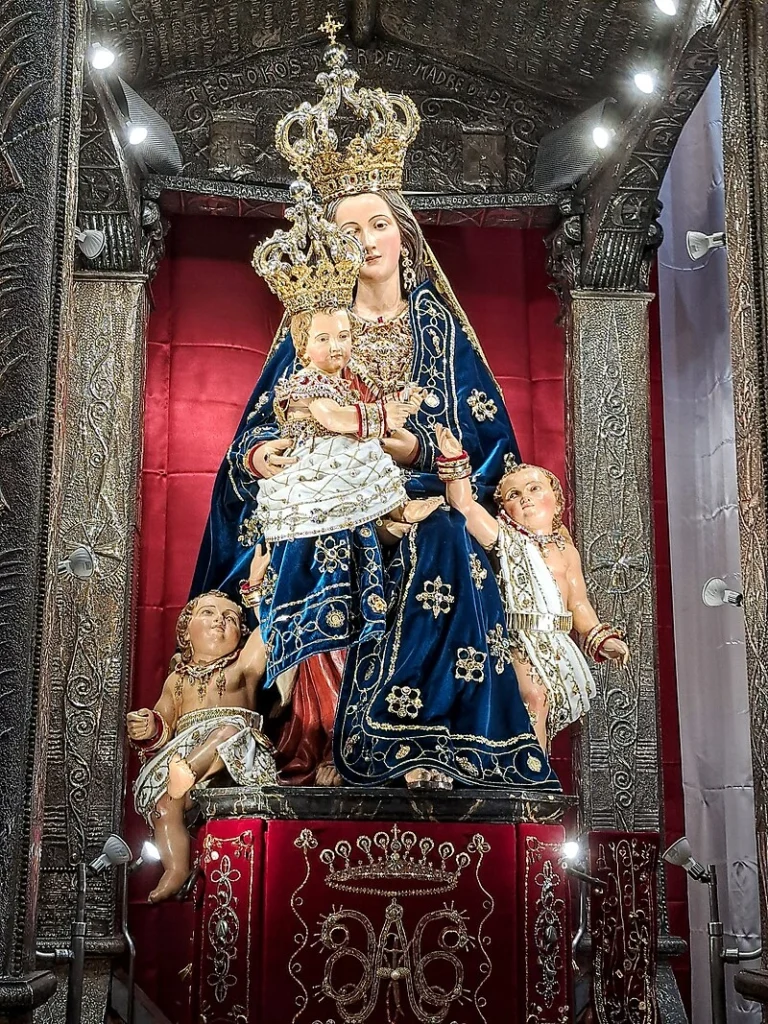
The 1874 Wooden Statue
In 1874, in response to the risk of damage to the original icon during processions, a wooden statue of the Virgin Mary was crafted by sculptor Vincenzo Genovese. The statue depicts the Virgin seated with the Child Jesus and two angels by her side. The statue stands 1.77 meters tall and 70 cm wide. Each year, prior to the patronal feast, the statue is adorned with a blue velvet cloak embroidered with gold, decorated with votive offerings donated by the faithful over the centuries.
Feast Day
Feast Day : Third Sunday of September
The Basilica-Sanctuary of the Most Holy Mary of Mazzaro in Mazzarino, Sicily, celebrates its feast day on the third Sunday of September. This event honors the Madonna del Mazzaro, the town’s patroness, whose miraculous icon was discovered in 1125. The celebration includes a novena, religious processions, and various local traditions, attracting pilgrims and visitors from the region.
Church Mass Timing
Yet to Update
Church Opening Time:
Daily : Open 24 Hours
Contact Info
Address : Basilica Sanctuary of the Most Holy Mary of Mazzaro
Corso Vittorio Emanuele II, 93013 Mazzarino CL, Italy
Phone : +39 0934 381085
Accommodations
Connectivities
Airway
Basilica Sanctuary of the Most Holy Mary of Mazzaro, Mazzarino, Sicily, Italy, to Vincenzo Bellini Catania Airport (CTA),, distance between 1 hr 41 min (108.6 km) via SS417.
Railway
Basilica Sanctuary of the Most Holy Mary of Mazzaro, Mazzarino, Sicily, Italy, Mazzarino Railway Station, distance 8 min (2.1 km) via Via Leonardo Da Vinci.

